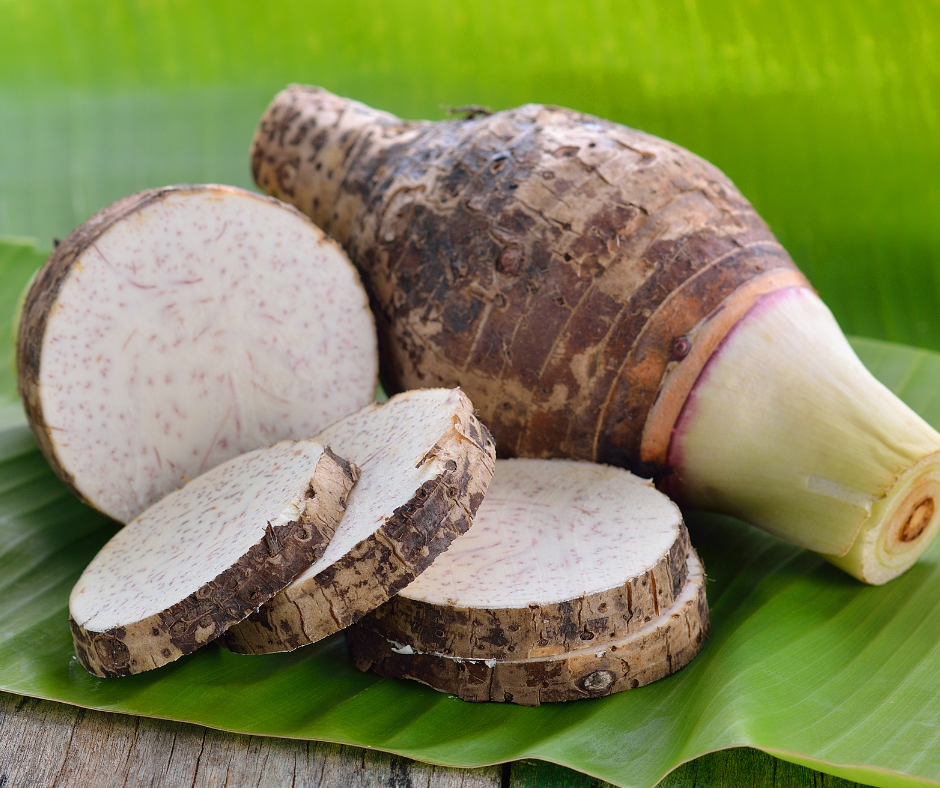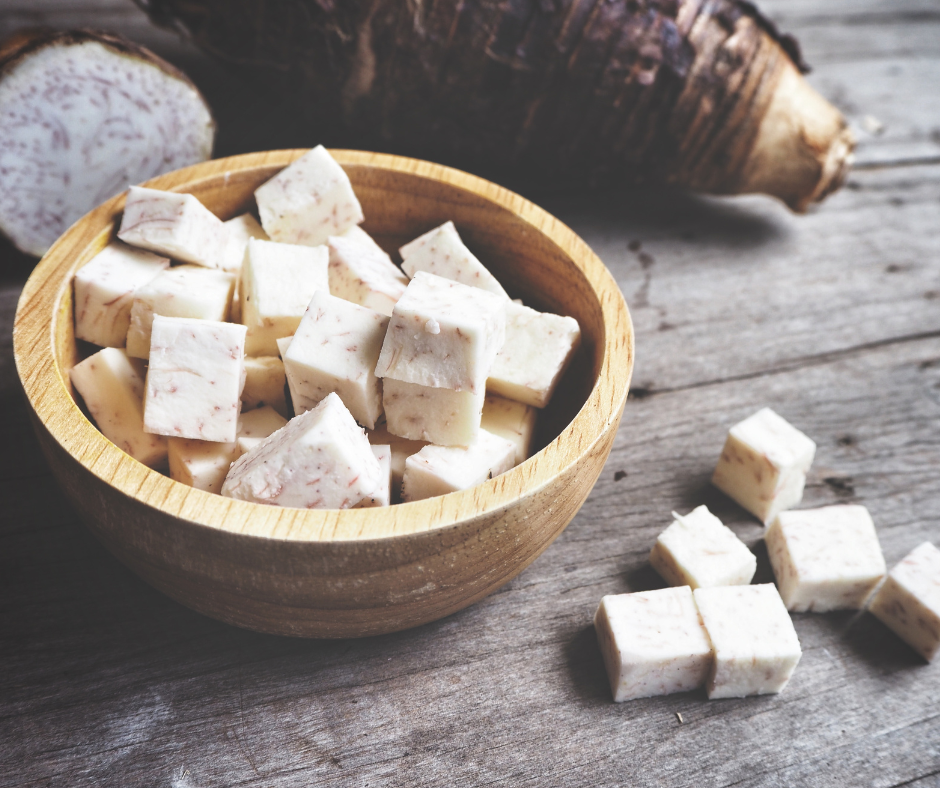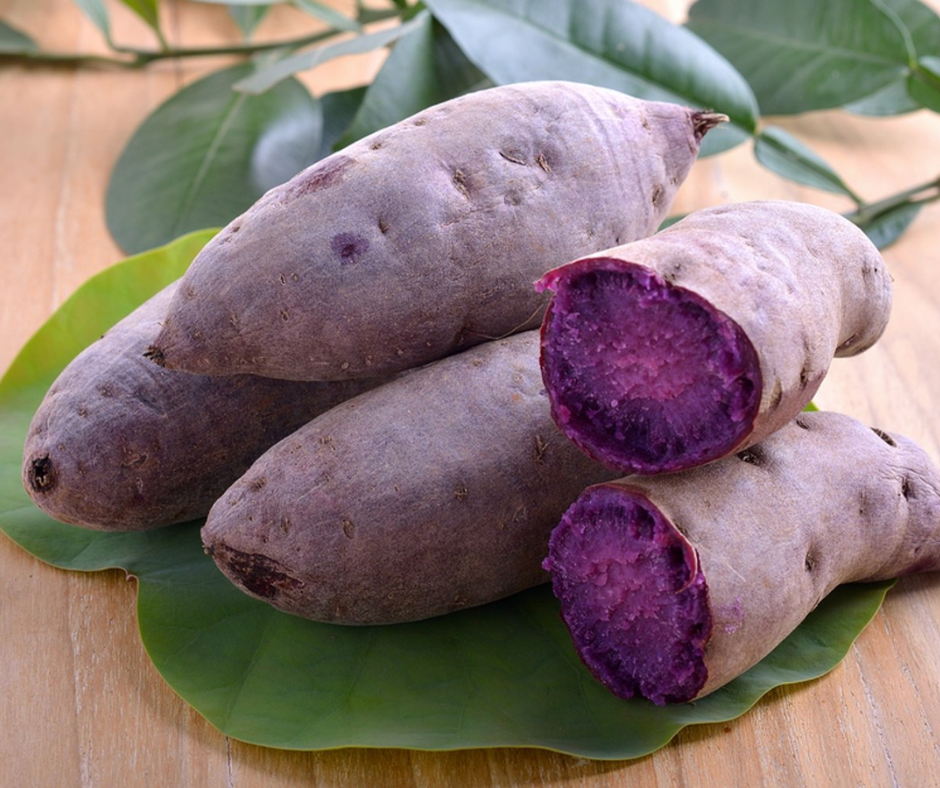Introduction
An Overview Of Two Unique Root Vegetables
Taro and ube are two distinct root vegetables that have gained popularity in the culinary world. Both offer unique flavors, vibrant colors, and versatile culinary uses. Let’s explore the origins, popularity, and culinary applications of Taro vs Ube.
Origin And Popularity Of Taro And Ube
Taro, scientifically known as Colocasia esculenta, is a root vegetable native to Southeast Asia and India. It has been cultivated for centuries and is a staple food in many cuisines. Taro has a mild and nutty flavor with a slightly sweet aftertaste. It is commonly used in savory dishes such as stews, soups, and curries, but it can also be baked, boiled, or fried to make chips or fries.
Ube, also known as purple yam or Dioscorea alata, is native to the Philippines and other parts of Southeast Asia. It is known for its vibrant purple flesh and sweet flavor. Ube is incredibly versatile and can be used in sweet and savory dishes. In Filipino cuisine, it is often used in desserts such as cakes, ice creams, and pastries. Ube halaya, a sweet and creamy dessert made from mashed ube, is a popular delicacy in the Philippines.
Both taro and ube have gained popularity beyond their countries of origin. Their unique flavors, vibrant colors and nutritional benefits have attracted chefs, food enthusiasts, and health-conscious individuals worldwide. They have become trendy ingredients in traditional and fusion cuisines in recent years.
Culinary Applications
Taro and Ube offer a wide range of culinary possibilities. Here are some popular applications for Taro vs Ube:
- Taro: Taro can be used in various forms, including steamed, boiled, mashed, or dried. In traditional Asian cuisines, taro is commonly used in stews, stir-fries, and dumplings. Its starchy texture makes it ideal for thickening soups and sauces. Taro chips, a popular snack, are made by slicing taro into thin rounds and frying them until crispy. It can also be used in desserts, such as taro-flavored ice cream or taro buns.
- Ube: Ube is commonly used in desserts due to its natural sweetness and vibrant purple color. It is often mashed or pureed and used as a filling for cakes, pastries, and bread. Ube halaya, a popular Filipino dessert, is made by simmering mashed ube with coconut milk and sugar until it thickens into a creamy paste. Ube-flavored ice cream, candies, and shakes are also popular.
Both taro and ube offer unique flavors, colors, and textures that add depth and excitement to various dishes. Their versatility allows chefs to experiment and create innovative recipes that showcase the distinct characteristics of each root vegetable.
In conclusion, taro and ube are two root vegetables that have captured the attention of food lovers worldwide. Whether it’s taro’s mild and nutty flavor or the sweet and vibrant purple flesh of ube, both offer a unique culinary experience. Their versatility in sweet and savory dishes has made them popular ingredients in many cuisines. So, whether you’re craving a hearty taro stew or indulging in a slice of ube cake, these root vegetables will satisfy your taste buds.

Taro: The Earthy And Starchy Root Vegetable
With its earthy flavor and starchy texture, Taro is a root vegetable that has recently gained significant popularity. Known by its scientific name Colocasia esculenta, taro is native to Southeast Asia and India and has been cultivated for centuries. It is a staple crop in many cuisines and offers a unique culinary experience.
Taro Taste And Texture
Taro has a distinct flavor that can be described as mild and nutty, with a slightly sweet aftertaste. Its flavor is often compared to a combination of potatoes and artichokes. The starchy nature of taro gives it a creamy and smooth texture when cooked, making it an excellent ingredient for soups, stews, and curries.
When prepared properly, taro becomes melt-in-your-mouth tender, allowing it to soak up the flavors of the cooked dish. Its versatility in cooking methods, such as baking, boiling, or frying, opens up many possibilities for using taro in various recipes.
Nutritional Value And Health Benefits Of Taro
Besides its delicious taste and versatile culinary uses, taro is packed with essential nutrients and offers several health benefits. It is an excellent source of dietary fiber, which aids digestion and promotes a healthy digestive system. The fiber content in taro also helps regulate blood sugar levels by slowing down the absorption of carbohydrates, making it a suitable choice for individuals with diabetes or those seeking to maintain stable blood sugar levels.
Taro is also rich in vitamins and minerals, including potassium, C, E, and B6. Potassium is essential for maintaining proper heart health and regulating blood pressure. Vitamin C is known for its immune-boosting properties, while vitamin E acts as an antioxidant, protecting the body against cell damage. Vitamin B6 plays a crucial role in brain development and function.
Furthermore, taro is gluten-free and a good option for individuals following a gluten-free diet. It can be used as a substitute for wheat-based products in various recipes, providing a nutritional alternative.

Ube: The Distinct And Sweet Root Vegetable
Ube takes the stage with its distinct flavor and vibrant purple flesh regarding unique root vegetables. Known scientifically as Dioscorea alata, Ube has gained significant popularity in the culinary world, particularly in the Philippines and other parts of Southeast Asia. Let’s delve into the flavor profile and texture of Ube, as well as its nutritional value and health benefits.
Ube Flavor Profile And Texture
Ube offers a delightful combination of sweetness and earthiness, making it a standout ingredient in various dishes and desserts. Its natural sweetness is often compared to a mix of sweet potatoes and vanilla, providing a truly unique taste experience. When cooked, Ube develops a creamy and smooth texture that melts in your mouth, adding a luxurious quality to any recipe.
This root vegetable’s vibrant purple flesh not only adds visual appeal to dishes but also a subtle, natural color. It can be mashed or pureed to create a smooth texture, making it ideal for fillings in cakes, pastries, and bread. Ube halaya, a popular Filipino dessert, exemplifies the versatility of Ube as it is made by simmering mashed Ube with coconut milk and sugar until it thickens into a luscious, creamy paste. Ube-flavored ice cream, candies, and shakes are also beloved treats that showcase this root vegetable’s unique flavor and texture.
Nutritional Value And Health Benefits Of Ube
Not only is Ube a delight for the taste buds, but it also comes packed with important nutrients and health benefits. Ube is rich in dietary fiber, promoting a healthy digestive system and aiding in digestion. The fiber content in Ube also regulates blood sugar levels, making it a viable option for individuals with diabetes or those seeking to maintain stable blood sugar levels.
In addition to fiber, Ube is a good source of vitamins and minerals. It contains vitamin C, which boosts immunity and acts as an antioxidant, protecting the body against cell damage. Ube also provides vitamin A, essential for maintaining healthy eyesight and promoting skin health. Furthermore, Ube is a potassium-rich root vegetable that supports heart health and helps regulate blood pressure.
Ube owes its captivating purple color to anthocyanins, powerful antioxidants in certain fruits and vegetables. These antioxidants help protect the body against free radicals, reducing the risk of chronic diseases and promoting overall health.
Furthermore, Ube is a complex carbohydrate, providing sustained energy and making it a good choice for individuals seeking a nutritious and filling food source. Its natural sweetness allows for the creation of indulgent dishes without excessive added sugar.
In conclusion, Ube stands out for its distinct flavor, vibrant color, and versatile culinary uses. Its unique taste, sweetness and earthiness, and creamy texture make it a beloved ingredient in both savory dishes and sweet desserts. Furthermore, Ube offers valuable nutritional benefits, including dietary fiber, vitamins, minerals, and antioxidants.
So, whether you savor the mild and nutty flavor of Taro or indulge in the distinctively sweet and visually striking Ube, both root vegetables bring depth and excitement to various recipes. With their nutritional value and health benefits, Taro and Ube provide delicious options for individuals looking to maintain a balanced and nutritious diet. So go ahead and explore the delightful battle of tastes between Taro and Ube, and let your taste buds rejoice in their unique flavors.

Taro Vs Ube: A Comparison
Taste And Flavor Differences Between Taro And Ube
Taro and Ube are two unique root vegetables that have gained popularity for their distinct taste and flavor profiles. Taro and Ube share similarities in appearance and texture, but their flavors set them apart in the culinary world.
Taro, known scientifically as Colocasia esculenta, offers a mild and nutty flavor. Its taste is often compared to a combination of sweet potato and chestnut. Taro has a subtle sweetness that is balanced with earthy undertones. This versatile vegetable can be cooked in various ways, allowing its flavor to shine through in soups, stews, and stir-fries.
On the other hand, Ube, scientifically known as Dioscorea alata, is renowned for its unique, sweet flavor. Its taste is often described as a delightful combination of sweet potatoes and vanilla. Ube’s natural sweetness lends well to desserts and sweet treats, making it a popular ingredient in ice creams, candies, cakes, and pastries.
Texture And Cooking Applications Of Taro And Ube
While taro and ube have distinct flavors, they also differ in texture, affecting their cooking applications.
Taro has a starchy and firm texture when cooked. Depending on the desired recipe, it can be boiled, steamed, roasted, or fried. Taro is often used as a filling in dumplings or a main ingredient in dishes like taro chips or taro cakes. Its creamy consistency, when cooked, gives a smooth and rich dimension to various culinary creations.
On the other hand, Ube has a soft and creamy texture when cooked. It can be mashed or pureed, making it ideal for desserts and sweets. Ube is a popular ingredient in Filipino cuisine, where it is used to make desserts like Ube halaya, Ube ice cream, and Ube-flavored cakes and pastries. Its vibrant purple flesh also adds an attractive visual element to any dish.
When it comes to cooking applications, both taro and ube offer versatility. They can be used in sweet and savory dishes, allowing chefs and home cooks to experiment with different recipes and create unique culinary experiences.
In summary, taro and ube are distinct root vegetables with unique flavors and textures. Taro boasts a mild and nutty taste, while Ube delights with its sweet and creamy flavor. Taro’s starchy and firm texture lends itself well to savory dishes, while Ube’s soft and creamy texture is perfect for indulgent desserts. Whether you prefer the mild and earthy taste of taro or the sweet and vibrant flavor of Ube, both root vegetables offer a delightful culinary adventure. So, go ahead and explore the delicious battle of tastes between taro and ube, and let your taste buds rejoice in their unique flavors.
Conclusion
In conclusion, comparing Taro vs Ube reveals these two root vegetables’ unique taste, flavor, and texture profiles. Taro offers a mild and nutty flavor with subtle sweetness and earthy undertones, making it a versatile ingredient for savory dishes. On the other hand, Ube is renowned for its sweet and creamy flavor, reminiscent of sweet potatoes and vanilla, and is widely used in desserts and sweet treats.
The choice between Taro and Ube ultimately boils down to personal preference. Some individuals may prefer the mild and earthy taste of Taro, while others may be drawn to the sweet and vibrant flavor of Ube. Both vegetables provide a delightful culinary experience and can be used in various recipes to create unique and flavorful dishes.
For those who enjoy Taro, numerous recipes and dishes highlight its starchy and firm texture. Taro can be boiled, steamed, roasted, or fried, and it is often used as a filling in dumplings or as the main ingredient in dishes like taro chips or taro cakes. Its creamy consistency, when cooked, adds a smooth and rich dimension to these culinary creations.
This root vegetable’s soft and creamy texture Ube enthusiasts, lends itself well to desserts and sweets. Ube can be mashed or pureed, making it ideal for creating indulgent treats such as Ube halaya, Ube ice cream, and Ube-flavored cakes and pastries. Additionally, the vibrant purple flesh of Ube adds an attractive visual element to any dish, making it visually appealing and delicious.
Ultimately, the delicious battle between Taro and Ube offers a wonderful opportunity to explore and experiment with different recipes and flavors. Whether incorporating Taro into savory dishes or indulging in Ube-flavored desserts, both vegetables provide a delightful culinary adventure.
So, whether you prefer the mild and earthy taste of Taro or the sweet and vibrant flavor of Ube, the choice is yours. Embrace these root vegetables’ unique flavors and textures and let your taste buds rejoice in the delicious battle between Taro and Ube.
FAQs
- What is the main difference when you compare Taro vs Ube?
Taro and ube are root vegetables but differ in taste, texture, and nutritional value. Taro has an earthy, starchy taste with a creamy and slightly fibrous texture. On the other hand, ube has a distinct and sweeter taste with a smooth and velvety texture. - Which one is sweeter, taro or ube?
Ube is generally sweeter than taro. It contains more natural sugars, giving it a sweeter taste. If you prefer sweet flavors, ube might be your better option. - Are there any nutritional differences between taro and ube?
Regarding calories, both taro and ube are similar, with around 140 to 180 calories per serving. However, ube tends to be higher in sugar and is rich in antioxidants. If you are looking for a root vegetable with higher antioxidant content, ube could be your choice. - Can taro and ube be used interchangeably in recipes?
While taro and ube impart a slightly sweet and nutty flavor, they have distinct tastes and textures. Taro is commonly used in savory dishes like stews and soups and sweet treats like bubble tea and ice cream. With its sweeter and more delicate flavor, Ube is often reserved for desserts. Ultimately, the choice between taro and ube depends on the flavor profile you prefer for your dish. - How can I incorporate taro and ube into my meals?
Both taro and ube are versatile ingredients that can be used in various Asian cuisines. Taro adds a hearty and starchy element to savory dishes, while ube lends sweetness to desserts. Taro can be cooked in soups, stews, or mashed, while ube can be used in cakes, ice creams, and other sweet treats. Explore different recipes and experiment with these unique root vegetables to discover your preferred way to enjoy them. - Are there any health benefits to consuming taro and ube?
Taro and ube are both nutritious root vegetables. While taro is a good source of dietary fiber and contains vitamins C and E, ube is rich in antioxidants, which can help fight against cell damage caused by harmful free radicals. Including taro and ube in your diet can contribute to a well-rounded and varied intake of nutrients.
Remember, the choice between taro and ube ultimately depends on personal preference and the specific flavors and textures you enjoy. Both root vegetables offer unique culinary experiences, so don’t hesitate to explore and experiment with them in your cooking.
Graham Bartlett, owner at Taco and Piña Mexican food, is all about bringing the authentic flavors of Mexico to your plate. With Graham Bartlett, you can tantalize your taste buds with mouthwatering tacos and delicious piña coladas, all in one place. Stay connected and never miss a beat as Graham Bartlett takes you on a culinary journey through vibrant Mexican cuisine. Join the community and discover the perfect blend of flavor, culture, and passion that Graham Bartlett brings to the table. Experience the essence of Mexico, one bite at a time, with Graham Bartlett.
